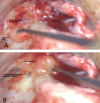Labyrinthine Fistulae in Squamosal Type of Chronic Otitis Media: Therapeutic Outcome
- PMID: 31223596
- PMCID: PMC6556750
Labyrinthine Fistulae in Squamosal Type of Chronic Otitis Media: Therapeutic Outcome
Abstract
Introduction: Labyrinthine fistulae (LF) are the common complications of chronic otitis media (COM) of squamosal variety. The final therapeutic outcome of this condition is to preserve the cochlear and vestibular functions. Herein, we present the data of the cases managed at our institute with respect to their presenting complaints, adopted therapeutic approaches and outcomes.
Materials and methods: A retrospective chart review was conducted on all cases with COM squamosal type in adult patients. A total of 275 patients were reviewed, out of whom 30 cases had LF. The results were mainly studied with respect to the postoperative improvement of hearing and vertigo.
Results: The incidence rate of LF in the present study was obtained at 10.9%. Only 50% of the cases had the symptoms of vertigo. Furthermore, positive fistula test was elicited in 3.3% of the cases. All cases undergoing preoperative imaging were diagnosed successfully. In addition, 42.85% of the cases had profound hearing loss preoperatively, which sustained after the operation. However, 47.61% of the cases showed an improvement of at least ≥ 10 dB in the air-bone gap. Out of the 15 LF cases with vertigo as the main complaint, only 11 cases referred for follow-up. In this regard, 63.63% of the cases had no postoperative vertigo symptoms.
Conclusion: Patients with LF may not have complaints of vertigo and a positive fistula sign upon admission. Pre-operative imaging facilitates the diagnosis of this condition. The removal of the matrix under constant irrigation, followed by repair with bone wax and/or autologous tissue, is sufficient to preserve the cochlear and vestibular symptoms postoperatively.
Keywords: Cholesteatoma; Hearing Loss; Labyrinth diseases; Middle Ear; Vertigo.
Figures
Similar articles
-
Clinical Study of Labyrinthine Fistula in Cholesteatomatous Chronic Otitis Media: A Tertiary Care Hospital-Based Retrospective Study in a South Indian Population.Cureus. 2023 Jul 25;15(7):e42413. doi: 10.7759/cureus.42413. eCollection 2023 Jul. Cureus. 2023. PMID: 37637549 Free PMC article.
-
Labyrinthine fistula after cholesteatomatous chronic otitis media.Am J Otol. 2000 Jan;21(1):32-5. Am J Otol. 2000. PMID: 10651432
-
[Studies of labyrinthine cholesteatoma-related fistulas: report of 22 cases].J Otolaryngol. 2005 Feb;34(1):1-6. doi: 10.2310/7070.2005.00001. J Otolaryngol. 2005. PMID: 15966468 Review. French.
-
[The clinical investigation of labyrinthine fistula associated with chronic otitis media].Lin Chuang Er Bi Yan Hou Ke Za Zhi. 2005 Feb;19(4):153-4. Lin Chuang Er Bi Yan Hou Ke Za Zhi. 2005. PMID: 15938205 Chinese.
-
Hearing and vertigo outcomes after congenital labyrinthine cholesteatoma resection.Am J Otolaryngol. 2014 May-Jun;35(3):417-23. doi: 10.1016/j.amjoto.2014.01.004. Epub 2014 Jan 10. Am J Otolaryngol. 2014. PMID: 24503247 Review.
Cited by
-
"Sandwich technique" enables preservation of hearing and antivertiginous effect in cholesteatomatous labyrinthine fistula.Eur Arch Otorhinolaryngol. 2022 May;279(5):2329-2337. doi: 10.1007/s00405-021-06934-y. Epub 2021 Jun 18. Eur Arch Otorhinolaryngol. 2022. PMID: 34143282 Free PMC article.
-
Floating labyrinth: A unique finding on CT scan.Radiol Case Rep. 2020 Sep 3;15(11):2104-2107. doi: 10.1016/j.radcr.2020.08.021. eCollection 2020 Nov. Radiol Case Rep. 2020. PMID: 32944108 Free PMC article.
-
Labyrinthine Fistula in Cholesteatoma Patients: Outcomes of Partial Labyrinthectomy With "Underwater Technique" to Preserve Hearing.Front Neurol. 2022 Mar 2;13:804915. doi: 10.3389/fneur.2022.804915. eCollection 2022. Front Neurol. 2022. PMID: 35309574 Free PMC article.
-
Analysis of postoperative effects of different semicircular canal surgical technique in patients with labyrinthine fistulas.Front Neurosci. 2022 Nov 3;16:1032087. doi: 10.3389/fnins.2022.1032087. eCollection 2022. Front Neurosci. 2022. PMID: 36408412 Free PMC article.
-
Management of cochlear fistula and the role of hearing: a five-case report.Acta Otorhinolaryngol Ital. 2021 Dec;41(6):558-565. doi: 10.14639/0392-100X-N1237. Acta Otorhinolaryngol Ital. 2021. PMID: 34928267 Free PMC article.
References
-
- McCabe BF. Labyrinthine fistula in chronic mastoiditis. Ann Otol Rhinol Laryngol . 1983;93(suppl 112):138–41. - PubMed
-
- Sanna M, Zini C, Bacciu S, Scandellari R, Delogu P, Jemmi G. Management of the labyrinthine fistula in cholesteatoma surgery. ORL J OtorhinolaryngolRelat Spec. 1984;46:165–72. - PubMed
-
- Pulec JL. Labyrinthine fistula from cholesteatoma: surgical management. Ear Nose Throat J. 1996;75:143–8. - PubMed
-
- Magliulo G, Terranova G, Varacalli S, Sepe C. Labyrinthine fistula as a complication of cholesteatoma. Am JOto. 1997;18:697. - PubMed
-
- Manolidis S. Complications associated with labyrinthine fistula in surgery for chronic otitis media. Otolaryngol Head Neck Surg. 2000;123:733–7. - PubMed
LinkOut - more resources
Full Text Sources
Miscellaneous


